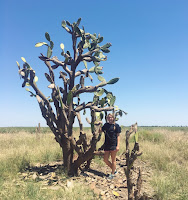Good morning! I apologize if I have seen a bit absent from social media the past few days. For my Cotton 300 class at UNE, I went on a 3 day excursion to Goondiwindi, Queensland to learn all about Australian cotton production. And I must say- I learned a ton! As the only person in the class who had never been around a cotton operation before (since it's pretty much corn and beans in midwest USA), I was able to broaden my agricultural and agronomic horizons immensely during the trip.
The first day consisted of familiarizing ourselves with the Shannon Cotton farm, operated by UNE cotton staff. We learned how to create a cotton map, varieties of cotton used, what the growing season looks like, and precision ag technologies used in the industry. I was intrigued to learn that 90% of cotton grown in Australia is GMO, and many growers are currently using a Monsanto Bollgard II (or III) variety. We also looked at a cotton picker and other types cotton machinery.

It was unbelievable to me how different the landscape and the soil was in Queensland compared to New South Wales (where UNE is located). The temperatues were much warmer. Because the soil cracks, many houses are mounted on stilt-like-structures to prevent potential damage and cracking. Additionally, there were cacti in pretty much any direction- even some that were three to four times taller than me! I was also super excited to spot some kangaroo tracks at a farm- they walk around at night similarly to how deer wander in Indiana.
 During the second day of the excursion, we learned about cotton irrigation systems. In Queensland, a lot of the cotton has to be irrigated (very costly) due to the climate. I got a chance to try to pull siphons in the fields; however, I definitely need some practice. We visited the Namoi cotton gin, receiving a first-hand look at how cotton is prepared for sampling from grower to merchant.
During the second day of the excursion, we learned about cotton irrigation systems. In Queensland, a lot of the cotton has to be irrigated (very costly) due to the climate. I got a chance to try to pull siphons in the fields; however, I definitely need some practice. We visited the Namoi cotton gin, receiving a first-hand look at how cotton is prepared for sampling from grower to merchant.
Our day finished with talking to a cotton marketer from the LDC (Louis Dreyfus Company). He explained to us that Australian cotton is so valued due to its consistent quality, reliable suppliers, and near-0 contamination levels. The marketer briefed us a little with the cotton grading system, emphasizing how it's based on a system developed by the USDA. He also shared with us some of the biggest buyers of Australian cotton- China, Indonesia, and other Asian countries.
 On the last day, our primary focus was cotton grading. A cotton grade is a 3-digit code based on the average samples from the front and back of a cotton bale. Cotton is ranked based on whiteness from 11-51 (11 being the whitest and creamiest color). From 33-37+ (with the Australian base being 36), cotton is graded based on its fiber lengths. A third number, from 1-6, is assigned based on the leaf content (1 represented the smallest and 6 representing the largest amount present in the sample). During our trip to the grading site, we saw them use an HVI (high volume instrument) on the samples to efficiently grade the cotton. Currently, there's a little discrepancy between using the machines versus hand grading, based on the fact that cotton in the US is different than that in Australia.
On the last day, our primary focus was cotton grading. A cotton grade is a 3-digit code based on the average samples from the front and back of a cotton bale. Cotton is ranked based on whiteness from 11-51 (11 being the whitest and creamiest color). From 33-37+ (with the Australian base being 36), cotton is graded based on its fiber lengths. A third number, from 1-6, is assigned based on the leaf content (1 represented the smallest and 6 representing the largest amount present in the sample). During our trip to the grading site, we saw them use an HVI (high volume instrument) on the samples to efficiently grade the cotton. Currently, there's a little discrepancy between using the machines versus hand grading, based on the fact that cotton in the US is different than that in Australia. 
Our final stop of the day was to the Goondiwindi Australia Cotton store. We learned how the family business started and got to see a final example of what cotton is used for in the market- and of course, that included a lot of clothes.
Even though we still have a lot more to cover throughout the semester, I can tell that this is definitely going to be a class I'll enjoy! I'm so happy I can take home the knowledge I gain about cotton production back home when I return to Purdue- especially because so few people in the midwest know about cotton! For now, I'll be catching up on all the classes had to miss for my trip. 😉
-Hallie


























